OPENNI MIGRATION GUIDE
OpenNI/NiTE 2Migration GuideTransitioning from OpenNI/NiTE 1.5 to
OpenNI/NiTE 2Document Version 1.0March 2013
Disclaimer and Proprietary Information Notice
The information contained in this document is subject to change without notice and does not
represent
a commitment by PrimeSense Ltd. PrimeSense Ltd.
and its subsidiaries make no warranty of any kind with regard to this material,
including, but not limited to implied warranties of merchantability
and fitness for a particular purpose whether arising out of law, custom, conduct or otherwise.
While the information contained herein is assumed to be accurate, PrimeSense Ltd. assumes no
responsibility
for any errors or omissions
contained herein, and assumes no liability for special, direct, indirect
or consequential damage, losses, costs, charges, claims, demands, fees or
expenses, of any nature or kind, which are incurred in connection with the
furnishing, performance or use of this material.
This document contains proprietary information, which is protected by U.S. and international
copyright laws.
All rights reserved. No part of this document may be reproduced, photocopied or translated into
another language
without the prior written consent of PrimeSense Ltd.
License Notice
OpenNI is written and distributed under the Apache License, which means that its source code is
freely-distributed and available to the general public.
You may obtain a copy of the License at:http://www.apache.org/licenses/LICENSE-2.0[1]
NiTE is a proprietary software item of PrimeSense and is written and licensed under the NiTE
License terms, which might be amended from time to time. You should have received a copy of
the NiTE License along with NiTE.
The latest version of the NiTE License can be accessed
at:http://www.primesense.com/solutions/nite-middleware/nite-licensing-terms/[2]
Trademarks
PrimeSense, the PrimeSense logo, Natural Interaction, OpenNI, and NiTE are trademarks and
registered trademarks of PrimeSense Ltd. Other brands and their products are trademarks or
registered trademarks of their respective holders and should be noted as such.
1 Introduction
1.1 Scope
This guide is targeted at developers using OpenNI versions that came before OpenNI 2, with
particular emphasis on those developers using OpenNI1.5.2 who are interested in transitioning
�
to OpenNI 2. This guide is designed as both an aid to porting existing applications from the old
API to the new API, as well as to enable experienced OpenNI developers to learn and understand
the concepts that have changed in this new API.
This guide provides a general overview to all programming features that have changed.
Included also is a lookup table of all classes and structures in OpenNI 1.5, showing the
equivalent functionality in OpenNI 2.
1.2 Audience
The intended audience of this document is the OpenNI 1.5.x developer community interested in
moving to OpenNI 2.
1.3 Related Documentation
[1] NiTE 2 Programmerӳ Guide, PrimeSense.
1.4 Support
The first line of support for OpenNI/NiTE developers is the OpenNI.org web site. There you will
find a wealth of development resources, including ready-made sample solutions and a large and
lively community of OpenNI/NiTE developers. See:
http://www.OpenNI.org[3]
If you have any questions or require assistance that you have not been able to obtain at
OpenNI.org, please contact PrimeSense customer support at:
Support@primesense.com[4]
2 Overview
2.1 New OpenNI Design Philosophy
OpenNI 2 represents a major change in the underlying design philosophy of OpenNI. A careful
analysis of the previous OpenNI API, version 1.5, revealed that it has many features that are
rarely or never used by the developer community. When designing OpenNI 2, PrimeSense has
endeavored to greatly reduce the complexity of the API. Features have been redesigned around
basic functionality that was of most interest to the developer community. Of especial
importance is that OpenNI 2 vastly simplifies the interface for communicating with depth
sensors.
2.2 Simplified Middleware Interface
The plug-in architecture of the original OpenNI has been removed completely. OpenNI 2 is now
strictly an API for communicating with sources of depth and image information via underlying
drivers. PrimeSense NiTE middleware algorithms for interpreting depth information are now
available as a standalone middleware package on top of OpenNI, complete with their own API.
Previously, the API was through OpenNI only and you included NiTE functionality via plug-ins.
The following high level diagram compares the OpenNI/NiTE 2 architecture with the
OpenNI/NiTE1.5 architecture.
�
[5]
Figure ?2-1: Comparison of OpenNI/NiTE 2 architecture with OpenNI/NiTE1.5
NiTE 2 API is summarized in Chapter ?10, and is described in detail in the NiTE 2 Programmerӳ
Guide.
PrimeSense is not aware of any third party middleware that actually made use of the provided
OpenNI plug-In interfaces. All known third party middleware simply had been built to run on top
of OpenNI. By simplifying the underlying interfaces that middleware developers are actually
using, it is hoped that third party middleware providers will find it easier to implement their
products on OpenNI.
�
2.3 Simplified Data Types
OpenNI 1.5 had a wide variety of complex data types. For example, depth maps were wrapped
in metadata. This made it more complicated to work with many types of data that, in their raw
form, are simply arrays. OpenNI 2 achieves the following:
Unifies the data representations for IR, RGB, and depth data
Provides access to the underlying array
Eliminates unused or irrelevant metadata
OpenNI 2 allows for the possibility of not needing to double buffer incoming data
OpenNI 2 solves the double buffering problem by performing implicit double buffering. Due to
the way that frames were handled in OpenNI 1.5, the underlying SDK was always forced to
double buffer all data coming in from the sensor. This had implementation issues, complexity
problems and performance problems. The data type simplification in OpenNI 2 allows for the
possibility of not needing to double buffer incoming data. However, if desired it is still possible
to double-buffer. OpenNI 2 allocates one or more user buffers and a work buffer.
2.4 Transition from Data Centric to Device Centric
The overall design of the API can now be described as device centric, rather than data centric.
The concepts of Production Nodes, Production Graphs, Generators, Capabilities, and other such
data centric concepts, have been eliminated in favor of a much simpler model that provides
simple and direct access to the underlying devices and the data they produce. The functionality
provided by OpenNI 2 is generally the same as that provided by OpenNI 1.5.2, but the
complicated metaphors for accessing that functionality are gone.
2.5 Easier to Learn and Understand
It is expected that the new API will be much easier for programmers to learn and begin using.
OpenNI 1.5.2 had nearly one hundred classes, as well as over one hundred supporting data
structures and enumerations. In OpenNI 2, this number has been reduced to roughly a dozen,
with another dozen or so supporting data types. The core functionality of the API can be
understood by learning about just four central classes:
openni::OpenNI
openni::Device
openni::VideoStream
openni::VideoFrameRef
Unfortunately, this redesign has required us to break backward compatibility with OpenNI 1.5.2.
The decision to do this was not made lightly; however, it was deemed necessary in order to
achieve the design goals of the new API.
2.6 Event Driven Depth Access
In OpenNI 1.5 and before, depth was accessed by placing a loop around a blocking function that
provided new frames as they arrive. Until a new frame arrived the thread would be blocked.
OpenNI 2 still has this functionality, but it also provides callback functions for event driven
depth reading. These callback functions are invoked on sensors becoming available (further
sensors can be connected to the host system while OpenNI is running), and on depth becoming
available.
�
3 Summary of New Classes
openni::OpenNI
openni::Device
openni::VideoStream
openni::VideoFrameRef
nite::UserTracker
nite::HandTracker
Provides the entry point and overall context for the library,
and provides access to devices, and to events related to
devices entering and leaving the system.Replaces:
OpenNI 1.5 Context class
Provides the connection to a device, for configuring it and
obtaining video streams (implemented as VideoStream
objects).A Device represents either:ޠphysical hardware
devicethat is producing actual streams of data- or ޠ-file
devicethat contains a recording taken from a physical
device.For each device there is one stream each for color,
IR, and depth.Replaces: OpenNI 1.5 Device class, the
Depth, IR, and Image Generator classes, an all production
nodes
Provides the means to start data generation, read
individual frames, obtain information about the streams,
and configure the streams.Replaces: OpenNI 1.5
DepthGenerator, IRGenerator, and ImageGenerator as the
direct source of data from the sensor.
Encapsulates all data relevant to a single frame of data,
regardless of its type, IR, Image, and Depth data
Replaces: data structures for IR data, image data, and
depth data in OpenNI 1.5
Captures the output of one or more streams in an ONI file.
speed change and looping.
Provides all functionality related to scene segmentation,
skeleton tracking, pose detection, and user tracking.
Provides all functionality related to hand tracking,
including gesture detection
openni::Recorder
openni::PlaybackControl Provides access to specific recording functionality, e.g.,
4 Overall Context – The OpenNI Class
4.1 Introduction
The OpenNI class provides the entry point and overall context for the library. The OpenNI class
also provides access to devices, and to events related to devices entering and leaving the
system. See the OpenNI 2 Programmerӳ Guide for a complete introduction to using the OpenNI
Class.
4.2 Replaces the Context class
The openni::OpenNI class provides the same overall functionality as the Context class did in
OpenNI1.5. The openni::OpenNI class provides a top level area where the overall state of the API
is stored. Any OpenNI 2 based application will start by running the initialization function in this
class.
In OpenNI 1.5, a complex system of Production Nodes, Generators, and Production Trees/Chains
was used to access depth data. In OpenNI 2 this has been simplified to a model where various
hardware sensors are represented by objects of Device class. Devices provide streams of data,
which in turn are composed of sequential FrameRefs (single video frames). The OpenNI class is
responsible for initializing the actual hardware drivers and making physical devices accessible
by Device objects.
�
Note that openni::OpenNI is implemented as a collection of static functions. Unlike the Context
class in OpenNI 1.5, it does not need to be instantiated. Simply call the initialize() function to
make the API ready to use.
4.3 Device Events (New Functionality)
OpenNI 2 now provides the following device events:
Device added to the system
Device deleted from the system
Device reconfigured
These events are implemented using an OpenNI::Listener class and various callback registration
functions. See the OpenNI 2 Programmerӳ Guide for details. The EventBasedRead sample
provided with OpenNI 2 provides example code showing how to use this functionality.
4.4 Miscellaneous Functionality
The various error types implemented in OpenNI 1.5 via the EnumerationErrors class have been
replaced with simple return codes. Translation of these codes into human readable strings is
handled by openni::OpenNI. This replaces the Xn::EnumerationErrors class from OpenNI 1.5.
OpenNI 1.5 provided a specific xn::Version class and XnVersion structure to deal with API
version information. In OpenNI 2, the OniVersion structure is provided to store the API version.
This information is accessed via a simple call to the openni::OpenNI::Version() function. This
replaces the xn::Version class and the XnVersion structure from OpenNI 1.5.
5 The OpenNI Device Class
5.1 Introduction
In OpenNI 1.5, data was produced by Ԑroduction NodesԮ There was a mechanism whereby
individual Production Nodes could specify dependency on each other, but in principal there was
(for example) no difference between a Depth Generator node that was providing data from a
camera, and a Hands Generator node creating hand points from that same data. The end
application was not supposed to care whether the hand points it was using were generated from
a depth map, or some other data source.
The old approach had a certain symmetry in how data was accessed, but it ignored the
underlying reality that in all real cases the raw data produced by a hardware device is either a
RGB video stream, an IR stream, or a Depth stream. All other data is produced directly from
these streams by middleware.
OpenNI 2 has switched to a metaphor that much more closely mimics the real life situation. In
doing so, we were able to reduce the complexity of interacting with hardware, the data it
produces, and the middleware that acts on that hardware.
The base of the new hierarchy is the Device class. A Device represents either:
ޠphysical hardware device that is producing actual streams of data
– or -
ޠfile device that contains a recording taken from a physical device.
�
The Device class is used to connect to a device, configure it, and to obtain video streams
(implemented as VideoStream objects). For each device there is one stream each for Color, IR,
and Depth.
The Device class in OpenNI 2 replaces the Device class in OpenNI 1.5, as well as replacing the
Depth, IR, and Image Generator classes.
Please see the OpenNI 2 Programmerӳ Guide for a complete introduction to using the Device
class.
5.2 Device Specific Capabilities
In OpenNI 1.5, there was a general Capability class that was intended to represent the
capability of a ԇeneratorԠin an abstract sense. Any feature or data source, whether a device or
algorithm or some other data source was supposed to be represented by some sort of capability.
A long list of possible capabilities was defined.
The FrameSync and AlternativeViewPoint mechanisms in OpenNI 1.5 have been replaced by a
simpler system in OpenNI 2. OpenNI 2 uses ‘DepthColorSync’ and ‘ImageRegistration’ to more
closely follow how real devices are actually configured. These represent underlying flags that
are set in firmware or hardware on a device wide basis
The ԁlternative Viewpoint CapabilityԠis now referred to as ԉmage RegistrationԮ
5.3 File Devices
In OpenNI 1.5, the playback of recorded data was handled by an explicit player object and the
use of virtual ԍock NodesԠto produce the data. OpenNI 2 changes this to a system where a
recording is specified in place of a physical device when the device is actually opened. The
caller to the Device:open() function provides a parameter specifying whether it is a sensor
device or a file device. If a recording is specified, after the initial call to the Device::open()
function, a recording is in every way identical to the output from a physical device.
An openni::PlaybackControl class is also defined to control additional capabilities specific to file
devices. The abilities to seek within a recording, loop the recording, and control the playback
speed are all provided.
Recordings are made with the openni::Recorder class. See chapter ?8 for more information on
the Recorder and PlaybackControl classes.
6 The OpenNI VideoStream Class
6.1 Introduction
The VideoStream Class replaces the DepthGenerator, IRGenerator, and ImageGenerator as the
direct source of data from the sensor. It provides the means to start data generation, read
individual frames, obtain information about the streams, and configure the streams. It also
encapsulates the functionality formerly contained in the CroppingCapability, MirrorCapability
classes, and some of the functionality of the GeneralIntCapability class.
6.2 Changes to Access Approach
Since the Generator classes have been eliminated, data is obtained directly from devices. To
create a video stream, simply create a VideoStream object, and call the
openni::VideoStream::create() function, passing in a valid Device object that will supply the data.
�
Once initialized, there are two options for obtaining data: a polling loop, and event driven
access.
Polling is most similar to the functionality of the WaitXUpdateX() family in OpenNI 1.5. To
perform polling , call the openni::VideoStream::start() function on a properly initialized
VideoStream object. (A properly initialized VideoStream object is where a device has been
opened, a stream has been associated with the device, and the start command has been given.
Then, call the openni::VideoStream::readframe() function. This function will block until a new
frame of data is read.
To access data in an event driven manner, you need to implement a class that extends the
openni::VideoStream::Listener class, and write a callback function to handle each new data
frame. See the OpenNI 2 Programmerӳ Guide for more information.
6.3 Getting Stream Information
The openni::VideoStream::getSensorInfo() function is provided to obtain a SensorInfo object for
an initialized video stream. This object allows enumeration of available video modes supported
by the sensor.
The openni::VideoMode object encapsulates the resolution, frame rate, and pixel format of a
given VideoMode. Openni::VideoStream::getVideoMode() will provide the current VideoMode
setting for a given stream.
Functions are also provided by the VideoStream class that enable you to check resolution, and
obtain minimum and maximum values for a depth stream.
6.4 Configuring Streams
To change the configuration of a stream, use the OpenNI::VideoStream:setVideoMode() function.
A valid VideoMode should first be obtained from the list contained in a SensorInfo object
associated with a VideoStream, and then passed in using setVideoMode().
6.5 Mirroring Data
Instead of a ԍirroring CapabilityԬ mirroring is now simply a flag set at the VideoStream level.
Use the VideoStream::setMirroringEnabled() function to turn it on and off.
6.6 Cropping
Instead of a ԃropping CapabilityԬ cropping is now set at the VideoStream level. This is done
directly with the VideoStream::setCropping() function. The parameters to be passed are no
longer encapsulated in a ԃroppingԠobject as they were in OpenNI 1.5 ֠they are now simply a
collection of 4 integers.
6.7 Other Properties
The ԇeneral IntԠcapabilities have been replaced with simple get and set functions for integer
based sensor settings. Use of these should be rare, however, since all of the commonly used
properties
(i.e., mirroring, cropping, resolution, and others) are encapsulated by other functions rather
than manipulated directly.
.
�
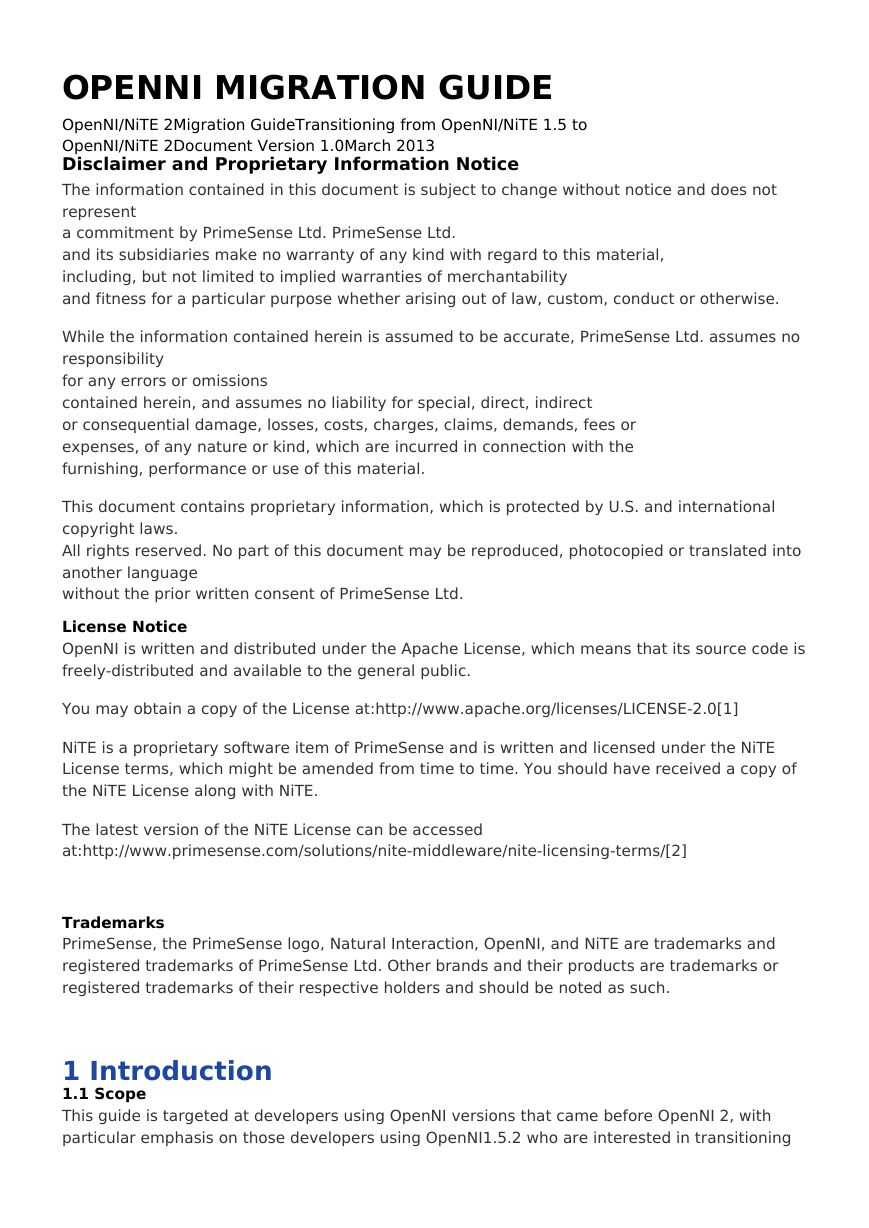
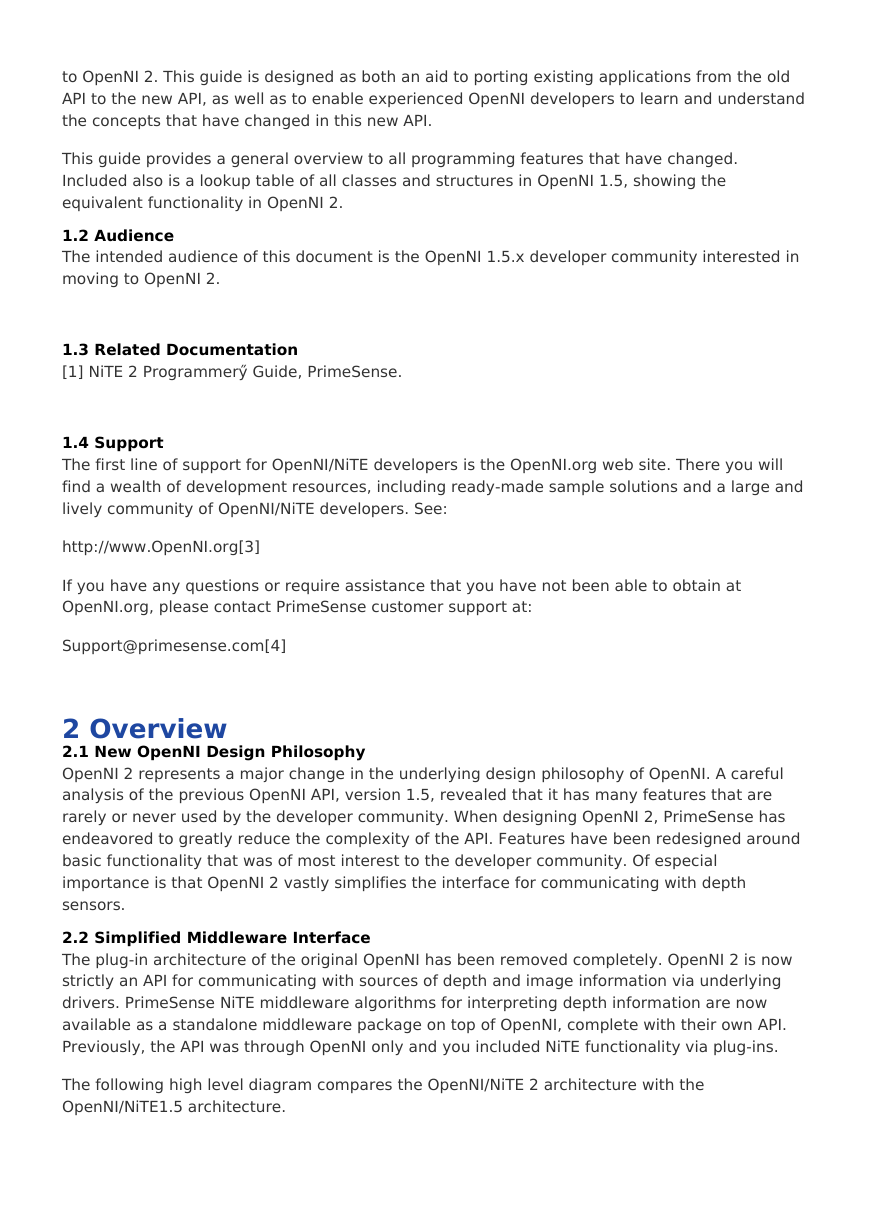
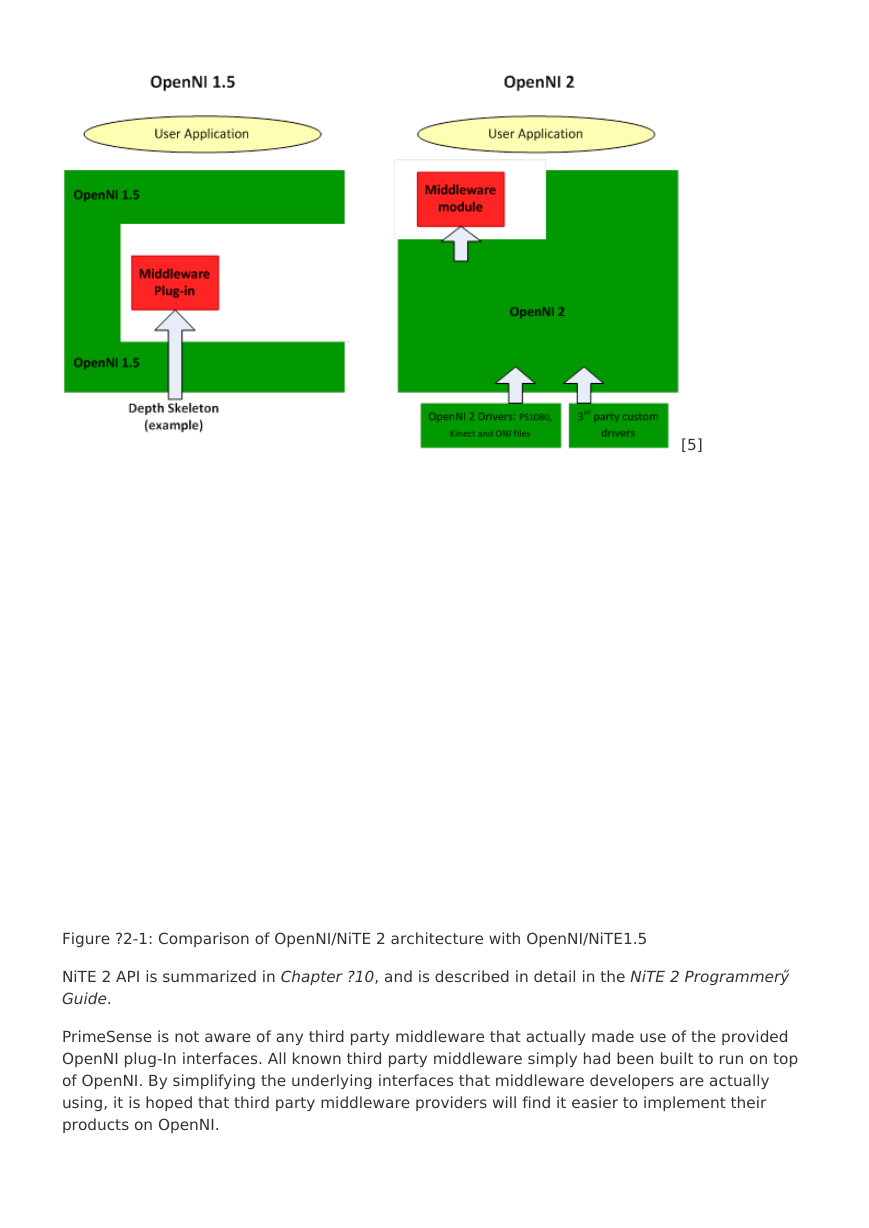
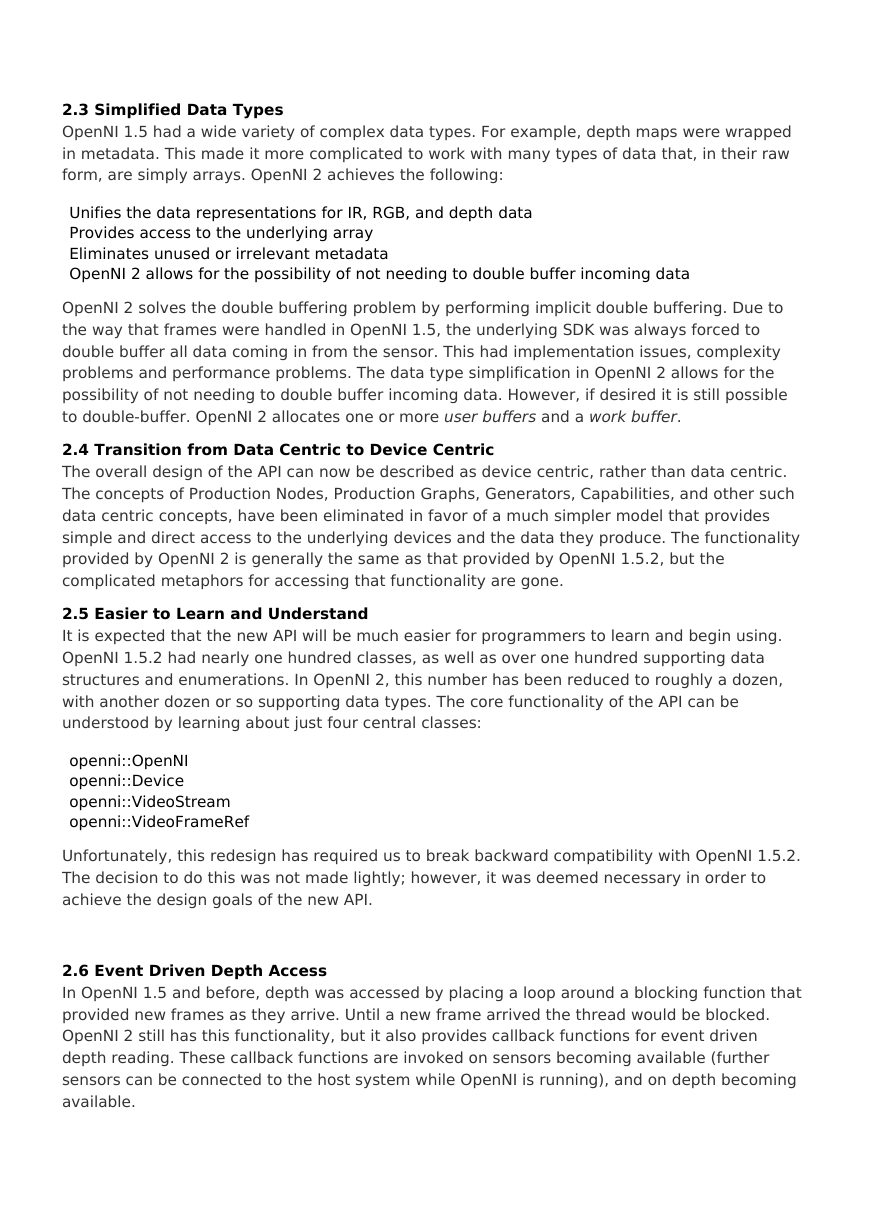


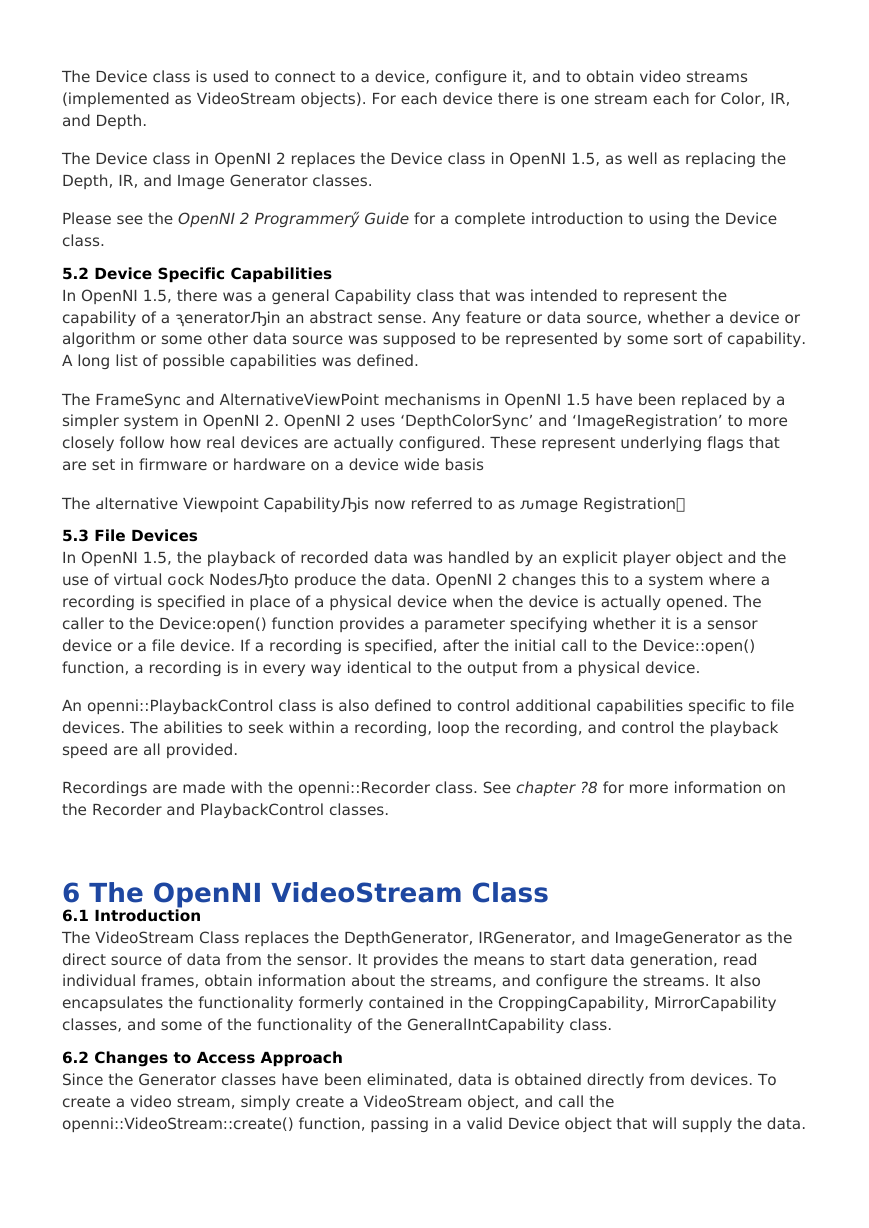









 2023年江西萍乡中考道德与法治真题及答案.doc
2023年江西萍乡中考道德与法治真题及答案.doc 2012年重庆南川中考生物真题及答案.doc
2012年重庆南川中考生物真题及答案.doc 2013年江西师范大学地理学综合及文艺理论基础考研真题.doc
2013年江西师范大学地理学综合及文艺理论基础考研真题.doc 2020年四川甘孜小升初语文真题及答案I卷.doc
2020年四川甘孜小升初语文真题及答案I卷.doc 2020年注册岩土工程师专业基础考试真题及答案.doc
2020年注册岩土工程师专业基础考试真题及答案.doc 2023-2024学年福建省厦门市九年级上学期数学月考试题及答案.doc
2023-2024学年福建省厦门市九年级上学期数学月考试题及答案.doc 2021-2022学年辽宁省沈阳市大东区九年级上学期语文期末试题及答案.doc
2021-2022学年辽宁省沈阳市大东区九年级上学期语文期末试题及答案.doc 2022-2023学年北京东城区初三第一学期物理期末试卷及答案.doc
2022-2023学年北京东城区初三第一学期物理期末试卷及答案.doc 2018上半年江西教师资格初中地理学科知识与教学能力真题及答案.doc
2018上半年江西教师资格初中地理学科知识与教学能力真题及答案.doc 2012年河北国家公务员申论考试真题及答案-省级.doc
2012年河北国家公务员申论考试真题及答案-省级.doc 2020-2021学年江苏省扬州市江都区邵樊片九年级上学期数学第一次质量检测试题及答案.doc
2020-2021学年江苏省扬州市江都区邵樊片九年级上学期数学第一次质量检测试题及答案.doc 2022下半年黑龙江教师资格证中学综合素质真题及答案.doc
2022下半年黑龙江教师资格证中学综合素质真题及答案.doc